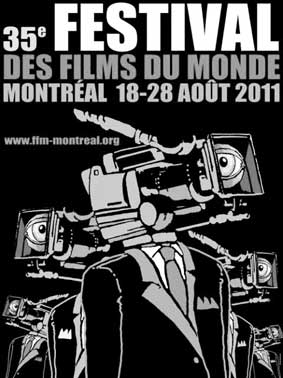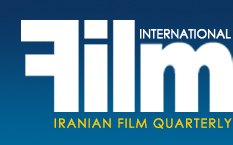|
35th Montreal World Film Festival (August 18-28, 2011)
Around the World in Ten Days
by Ramin S. Khanjani
|
 In contrast to the other major Canadian film festival in Toronto, in Montreal film festival the glamour of the star-studded cinema has been relinquished in favor of a kaleidoscopic presentation of films coming from across the world. The guests I met during the festival unanimously pointed to this obvious difference of scope, and the fact that more than 70 countries have been delegated in this edition of the festival is instructive in this respect. Of course, in the spirit of an A-class festival, the opening included a red carpet ceremony nonetheless, among the crowd strolling toward Theatre Maisonneuve a familiar face was difficult to spot. The closing ceremony, however, was attended by a high-profile star and a collaborator to legendry authors: Catherine Deneuve. She had been invited to the closing ceremony to receive an honorary prize and the organizers completed their tribute by screening Les Yeux de sa mere, one of her latest films, in out-of-competition section of the festival. The other renowned figure showing up during the festival was the veteran French director, Claude Lelouch who ran a master class during the festival and at the closing ceremony was invited to the stage to present the award for the best director. As one might suspect, this kind of set-up allowed a closer contact between filmmakers and their audiences. Aside from the press conferences held on a daily basis at Hyatt Regency Hotel – where the press office and film market were situated as well – the spectators had a chance to speak to directors and throw their questions at them either during a brief Q&A following each screening or simply by directly approaching them. The programs and the choice of the films were, therefore, very much geared to these spectators and their keenness to expand their knowledge about the world and different cultures, a typical feature of Canadian community which is modelled upon the concept of a “cultural mosaic.” The emphasis on the term “world” in the title of the festival – and its repetition in the titles of its different program – sounded all the more relevant here as it succinctly clarified the objectives of the festival organizers. Also, through inclusion of films coming from a variety of nations, the festival organizers cleverly pandered to the expectations of the different ethnic groups present in their immigrant-founded society. A review of the titles included in the program revealed that some choices were made primarily on the basis of the appeal of their subject matters and this logic could justify the appearance of some confounding titles. In contrast to the other major Canadian film festival in Toronto, in Montreal film festival the glamour of the star-studded cinema has been relinquished in favor of a kaleidoscopic presentation of films coming from across the world. The guests I met during the festival unanimously pointed to this obvious difference of scope, and the fact that more than 70 countries have been delegated in this edition of the festival is instructive in this respect. Of course, in the spirit of an A-class festival, the opening included a red carpet ceremony nonetheless, among the crowd strolling toward Theatre Maisonneuve a familiar face was difficult to spot. The closing ceremony, however, was attended by a high-profile star and a collaborator to legendry authors: Catherine Deneuve. She had been invited to the closing ceremony to receive an honorary prize and the organizers completed their tribute by screening Les Yeux de sa mere, one of her latest films, in out-of-competition section of the festival. The other renowned figure showing up during the festival was the veteran French director, Claude Lelouch who ran a master class during the festival and at the closing ceremony was invited to the stage to present the award for the best director. As one might suspect, this kind of set-up allowed a closer contact between filmmakers and their audiences. Aside from the press conferences held on a daily basis at Hyatt Regency Hotel – where the press office and film market were situated as well – the spectators had a chance to speak to directors and throw their questions at them either during a brief Q&A following each screening or simply by directly approaching them. The programs and the choice of the films were, therefore, very much geared to these spectators and their keenness to expand their knowledge about the world and different cultures, a typical feature of Canadian community which is modelled upon the concept of a “cultural mosaic.” The emphasis on the term “world” in the title of the festival – and its repetition in the titles of its different program – sounded all the more relevant here as it succinctly clarified the objectives of the festival organizers. Also, through inclusion of films coming from a variety of nations, the festival organizers cleverly pandered to the expectations of the different ethnic groups present in their immigrant-founded society. A review of the titles included in the program revealed that some choices were made primarily on the basis of the appeal of their subject matters and this logic could justify the appearance of some confounding titles.
In general, twelve venues were allocated to screening films from the different sections nine of which were auditoriums at the topmost floor of Cinema Quartier Latin. All venues were in downtown Montreal, in a conveniently close walking distance from each other. The central position of the venues allowed the visitors from outside the city to get a taste of the exuberance and vibrancy of Montreal, which is sensed in its more European-style downtown area. The following sections comprised corpus of the festival program: World Competition, First Film World Competition, Out of Competition, Focus on World Cinema, Documentaries of the World, and Short Documentary Films of Inis.
The 42nd Canadian Student Film Festival was also integrated into the program. All the films, if not in English, were subtitled, while use of French subtitles was limited to a number of theaters. Press conferences and Q&A sessions were held in both official languages. The only exception was the speech delivered by Serge Losique, the president of the festival in the closing ceremony which was not translated. The huge number of the screened films and the dominance of the unfamiliar names made choosing the right screening sometimes difficult. At times, the film you chose did not met the expectations its description in the catalogue induced, and later, you heard that you have missed a far better film shown in the adjacent theater. Anyway, the pleasure of these events lies in such explorations in dark rooms, and fortunately for the most of the films, at least three or four screenings were arranged, leaving little place for whining. My only complaint is about hospitality of the festival which seemingly had been almost exclusively offered to the filmmakers, while the press seemed to receive the smallest share of attention.
... To Be Continued
[Page: 131]
|
|
|
|
|
President & Publisher
Massoud Mehrabi
Editors:
Sohrab Soori
Massoud Mehrabi
Translators:
Sohrab Soori
Vazrik Der-Sahakian
Behrouz Tourani
Zohreh Khatibi
Contributors
Mehrzad Danesh
Advertisements
Mohammad Mohammadian
Art Director
Babak Kassiri
Ad Designers
Amir Kheirandish
Hossein Kheirandish
Cover Design
Alireza Amakchi
Correspondents
E.Emrani & M. Behraznia (Germany)
Mohammad Haghighat (France)
A. Movahed & M. Amini (Italy)
Robert Richter (Switzerland)
F. Shafaghi (Canada)
B. Pakzad (UAE)
H. Rasti (Japan)
Print Supervisors
Shad-Rang
Noghreh-Abi
Gol-Naghsh
Subscription & Advertising Sales
Address: 10, Sam St., Hafez Ave., TEHRAN, IRAN
Phone: +98 21 66722444
Fax: +98 21 66718871
info@film-magazine.com
Copyright: Film International
© All rights reserved,
2023, Film International
Quarterly Magazine (ISSN 1021-6510)
Editorial Office: 5th Floor, No. 10
Sam St., Hafez Ave., Tehran 11389, Iran
Printed in Tehran
Publishing Date Summer 2011
*
All articles represent views of their
authors and not necessarily
those of the editors
|
|
|

